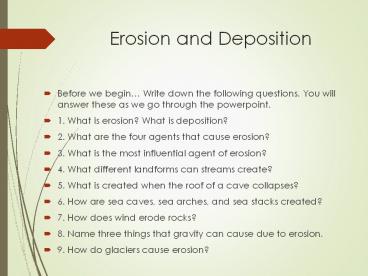Erosion and Deposition - PowerPoint PPT Presentation
1 / 19
Title:
Erosion and Deposition
Description:
Erosion and Deposition Before we begin Write down the following questions. You will answer these as we go through the powerpoint. 1. What is erosion? – PowerPoint PPT presentation
Number of Views:132
Avg rating:3.0/5.0
Title: Erosion and Deposition
1
Erosion and Deposition
- Before we begin Write down the following
questions. You will answer these as we go through
the powerpoint. - 1. What is erosion? What is deposition?
- 2. What are the four agents that cause erosion?
- 3. What is the most influential agent of erosion?
- 4. What different landforms can streams create?
- 5. What is created when the roof of a cave
collapses? - 6. How are sea caves, sea arches, and sea stacks
created? - 7. How does wind erode rocks?
- 8. Name three things that gravity can cause due
to erosion. - 9. How do glaciers cause erosion?
2
Erosion and Deposition
Erosion- process that moves weathered
sediments from one place to another Deposition-
the dropping of sediments that have been
eroded Sediment- The tiny grains of broken down
rock Erosion and deposition are two parts of the
same process. Erosion only occurs when there
is enough energy to carry the sediments.
Deposition occurs when the energy decreases.
3
(No Transcript)
4
There are four main forces that cause erosion and
deposition 1. Gravity 2. Running Water 3.
Glaciers 4. Wind
5
Water
- The most influential force of erosion is water
due to its ability to move materials from one
location to another and its vast presence over
earth. - Examples include bodies of water such as rivers
and streams.
6
Water
- Rivers and streams in the landscape cause erosion
and deposition and constantly shaping the land. - Moving water works with gravity to affect the
landforms that the water makes. - Channel- the path that a stream follows due to
the erosion from water on soil and rock. As the
channel gets wider and deeper, canyons and
valleys can form.
7
Floodplains
- When a stream floods, a layer of sediment is
deposited over the flooded land. Many layers of
deposited sediment can form a flat area called a
floodplain.
8
Delta
- When a stream empties into a body of water, such
as a lake of an ocean, its current slows and
deposits its load. Streams often deposit their
load in a fan shaped pattern called a Delta.
9
Alluvial Fan
- Alluvial fan is a fan-shaped deposit that forms
on dry land when a stream flows onto a flat land
surface from mountains or hills.
10
Groundwater
- Groundwater is the water located within the rocks
below earths surface. - Slightly acidic groundwater can cause erosion by
dissolving rock leading to the formation of caves - Sinkhole- occurs when the roof of a cave
collapses, leaving a circular depression.
11
Sinkhole Current Event Link
- http//www.cnn.com/2013/11/14/us/florida-sinkhole/
12
What forces shape a shoreline?
- Waves play a major part in building up and
breaking down a shoreline. - The first parts of the shoreline that waves meet
are the headlands. The waves slowing waves bend
towards the headlands, which concentrates the
waves energy. A huge amount of energy is released
when waves crash into headlands, causing the land
to erode.
13
What coastal landforms are made by erosion?
- Sea cliff- a cliff that is formed when waves
strike a cliffs base, wearing away the rock.
14
Sea Caves, Arches, and Stacks
- As the rock making up sea cliffs erodes, it
breaks and cracks. Waves can then cut deeply into
the cracks and form large holes that continue to
erode, which are known as sea caves. - Sea arch- A sea cave that has eroded even
further. - Sea stacks- isolated rock that forms when the
tops of sea arches collapse.
15
Wind
- Wind can erode rocks over a long period of time.
- When wind blows sand and other particles against
a surface, it can wear down the surface over
time. - The grinding and wearing down of rock surfaces
over time is known as abrasion.
16
Gravity
- Gravity works with other agents of erosion and
deposition which can result in landslides,
mudslides, and sinkholes. - The force of gravity can move water and ice and
make rock, soil, snow, or other material move
downhill.
17
Glacier
- A glacier is a large mass of moving ice that
forms by the compacting of snow. - As glaciers move due to gravity, they pick up
materials that become embedded in the ice. As the
glacier moves forward, the materials scratch and
abrade the rock and soil underneath the glacier,
causing more erosion - Glaciers are also agents of deposition. When a
glacier melts, it drops materials that it
carried. - A Glacial drift is the term for all of the
materials carried and deposited by a glacier. - Alpine glacier- A glacier that forms in a
mountainous area
18
Glaciers
19
(No Transcript)































